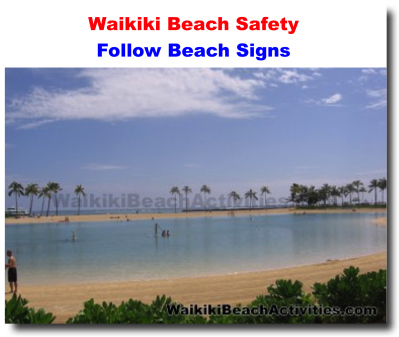Waikiki Beach Safety - Follow Beach Signs
- Tweet

With the wind in your hair and the sand on your feet, a day at the beach can be one of the most relaxing activities you can spend in Waikiki. While you're enjoying your Hawaii vacation, it's also important to pay attention to various beach signs that alert and warn beachgoers of hazardous conditions.
Some of these signs are permanent while others are posted daily, depending on ocean and beach conditions. If you're not sure what certain signs mean, be sure to ask a lifeguard.
Below are some of the common beach signs and their explantations. Descriptions are provided by the Ocean Safety and Lifeguard Services Division of the City and County of Honolulu. To view all signs, click HERE.
Jellyfish
Box Jellyfish regularly swarm to Hawaii's south and leeward shores 9 to 10 days after the full moon. Carybdea alata cause the most "nuisance" for beachgoers in Hawai`i. Don't go into areas where sighted, or if dead box jellyfish are seen on the beach. Observe posted signs. Symptoms of a sting include stinging, burning, redness, swelling of lymph nodes and in cases of severe reactions may result in difficulty with breathing, symptoms of shock and cardiac arrest.
High Surf
Large powerful waves are generated by winds and storms at sea sometimes thousands of miles from the Hawaiian Islands. Seasonal high surf occurs on all shores of Oahu. Typically, shorelines facing North, East and West receive high surf during winter months. Shores facing Southeast and Southwest receive high surf during summer months. If you are uncertain about your abilities don't go into the ocean during high surf; heed all posted high surf warnings! Your life could depend on it!
Man-O-War
Portuguese man-o-war are most commonly found along bays and beaches during strong onshore winds. They are high in number when winds blow in from the ocean onto land, so beachgoers are urged to observe posted signs. Symptoms of a sting include stinging, burning, redness, swelling of lymph nodes. If stung carefully pick off any visible tentacles. Rinse with fresh or salt water. Apply ice for pain. IMMEDIATE medical attention may be required for severe reactions.
Shark Sighted
Shark sighted signs are posted when a shark sighting is confirmed by Ocean Safety Lifeguards, or another reliable source. Do not enter the water in areas where signs are posted. If you see or encounter a shark notify Ocean Safety Personnel or call 911 immediately.
Sharp Coral
Most of Hawaii's beaches have sharp coral reefs close to the shoreline. Use caution when swimming in shallow reef areas. Foot protection is advised. Should you be injured, see a lifeguard for minor first aid assistance. Should coral become embedded deeply see your doctor as soon as possible to have it removed. Deep cuts should be attended to by a physician to avoid the risk of infection.
Strong Current
These are swift moving channels of water that are difficult to swim against. Strong currents frequently accompany high surf and rapid tide changes and can be recognized as a turbulent channel of water between areas where waves are breaking. When caught in a strong current -- Try to keep a level head, i.e., don't panic! Wave one or both hands in the air, and scream or call for help. Swim diagonally across the current, not against it.
Back to the top
Back to the top
ref no:33123
Please send questions about this website to webmaster
Copyright© 1999 - 2023 Waikiki Beach Activities. All rights reserved.
Terms of Use / Legal Disclaimer / Privacy Statement
Site Designed and Managed by MacBusiness Consulting
Terms of Use / Legal Disclaimer / Privacy Statement
Site Designed and Managed by MacBusiness Consulting
